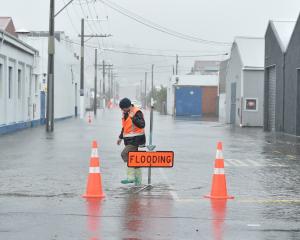The 1976 Winter Olympics downhill at Innsbruck was nearing its climax and she wanted her seat at the front of the TV.
My OE travelling companion John Thorburn and I were in Lech at the other end of Austria.
Four months earlier we'd set out from London in our Volkswagen campervan, driven by the confidence of youth that we'd spend the winter working in a European ski resort.
That we had barely a fortnight's ski experience between us was really quite a minor detail.
We eventually found Lech, via France, Italy and Switzerland.
The timing was perfect.
Just as the landscape was turning white and the VW had become a nightly icebox, we landed jobs as lifties.
Yes, of course we could ski, and learning German? Kein problem.
Fast forward.
Lunch over, and since the boss was in no hurry to restart the lift, John and I joined the throng of about 50 people watching the tiny screen.
The downhill was nearing its climax and the hopes of Austria rested with the skier in bib 15, the last of the top seeds.
There he was in the start gate, wearing a red and white helmet and a very yellow body-hugging catsuit that clearly showed he was a bloke.
He was a massive figure, looking every inch the gold medal super-hero his country hoped he was.
As he launched, a flurry of arms and legs, poles driving into the hard-packed snow, the restaurant erupted.
For the next one and three-quarter minutes I was mesmerised, transfixed by one of the greatest achievements in sport.
It was brutal and uncompromising.
There was nothing classical about his style.
He was on the ragged, ragged edge, courting disaster.
He was airborne, twisting, landing on a single ski, arms flaying as he somehow found balance for the next high-speed turn.
His legs pumped, loading and unloading over a Patscherkofel piste already grooved by many pairs of knife-edged skis.
His middle time was down - Austria went silent - but then he found something from deep within for the final assault, and within 30 seconds Austria rose in full voice to celebrate Franz Klammer's unlikely victory.
In 1987, I was fortunate to be back in Austria as the guest of Heinz Kinigadner, who had arranged a party to celebrate winning the world 250cc motocross championship.
A renowned joker, "Kini" had included the words "Bring your riding kit" on the invite.
To Austria, in November? On the outskirts of his small alpine village not far from Mayrhofen, he'd set up a little motocross track in the snow.
The party was about to start.
Grinning broadly, the towering figure of Kini announced he had also assembled an international cast of flag marshals - world champions Torsten Hallman, Andre Malherbe, Georges Jobe and Danny LaPorte, among them, plus other stars of the world off-road stage.
The good-natured humiliation of the media and other guests was about to begin.
But then, though his head was covered by a beanie and buried deep inside the upturned collar of a ski jacket, I saw familiar eyes.
Franz Klammer was here!Oh, how the memory can lie.
He wasn't this massive figure I'd seen on a flickering television screen.
He was the size of a mere mortal.
Smaller even.
Immediately, I decided that whatever bike he rode in his races, I'd claim it for mine.
It worked well.
I think I spoke just four words to him over the next hour or so.
"Wie gehts" and "danke sehr!".
He smiled as he handed me his bike and I smiled when I handed him his bike.
Sometimes a smile is all you need from a hero.












